Sicily (8)
Q1895939Sicily: large and rich island opposite the Italian mainland. In Antiquity, it was settled by Phoenicians and Greeks, and contested by the Carthaginians, Romans, Ostrogoths, and Byzantines.
Late Antiquity
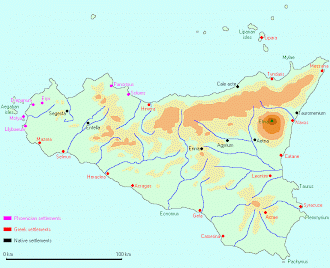
In the first and second century of our era, the superiority of the Roman empire was unchallenged. Far away from Italy and Sicily, the legions defended the frontiers, and the Mediterranean world was relatively quiet. The ancient cultures lived together more harmoniously than ever before or after. On Sicily, there were still people who spoke Phoenician, there were Greeks, and there were Romans, and they influenced each other in the most positive way. Sicilians are found as traders as far away as Xanten in Germania Inferior, and on the other hand, easterners settled on Sicily: we find diasporic Jews, Samaritans, and Christians at an early stage.
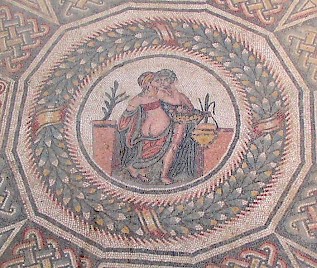
Yet, in spite of its power, there was something wrong in the Roman world. The imperial government failed to see that new enemies threatened the frontiers. In the north, powerful coalitions of Germanic tribes were being created, and it was a sign of the times that the emperor Marcus Aurelius (161-180) was unable to fully overcome them. In the east, Lucius Septimius Severus (193-211) defeated the old Parthian Empire, which was replaced by a far more powerful enemy, the Sasanian Persians. These enemies were dangerous, and the Roman government had to expand the number of legions, which in turn necessitated more taxes.
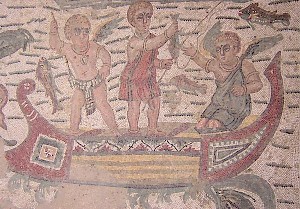
Unfortunately, the main consequence was inflation, and the result of this was an economic crisis. Military leaders capable of securing peace in a certain region were immediately proclaimed emperor, and the third century witnesses a swift succession of monarchs.Sicily was only indirectly threatened by all these problems. The Germanic tribes and the Sasanians were far away, and even if they broke through (which happened every now and then), they were no sailors and the island remained safe. It is remarkable that the soldiers' cult of the god Mithras is almost absent from Sicily. Yet, the islanders had to pay taxes, and so they got indirectly involved in the crisis. In fact, this tells something - albeit in an unexpected way - about Rome's success in creating a Mediterranean unity.
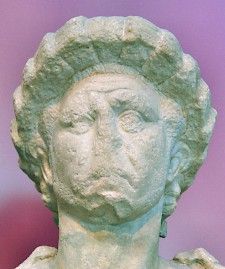
By the end of the third century, the emperors Diocletian and Maximianus reorganized the empire and its defenses. The Roman world became more military and bureaucratic. One of the measures was the division in an eastern, Greek-speaking half, and a western, Latin half (the "tetrarchy"). Sicily was included in the latter, which may suggest that, even if there were still people speaking Greek (which is uncertain), it had by now become truly romanized and had lost much of its Greek character.
To the early fourth century belongs one of the greatest monuments of Sicily, the palace villa at Piazza Armerina, which is famous for its mosaics. It has been assumed that it once was the residence of the emperor Maximianus, who resigned in 305 and briefly lived on a country estate on Sicily.;
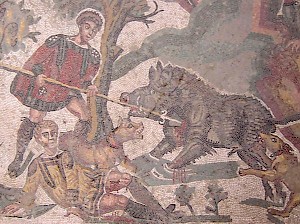
After the reforms of Diocletian and Maximianus, which were brought to their logical conclusion by Constantine I the Great (also known for his conversion to Christianity), the new Roman empire remained quiet for another century. However, the Germanic Visigoths were able to sack Rome in 410, an event that shocked the Roman world. At more or less the same time, the Rhine frontier temporarily collapsed and several tribes crossed into Gaul and Hispania. The Vandals even crossed from [V]Andalusia to the Maghreb and captured Carthage. They became notorious pirates, and often raided Sicily. The decline of the Roman empire, that had started somewhere after 235, now reached Sicily - with two centuries delay.
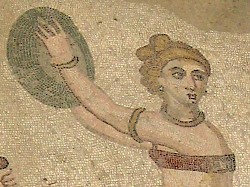
By now, recovery had become impossible, and after the mid-fifth century, the western half of the Roman empire gradually disintegrated. After 440, Sicily was occupied by the Vandals, but later, it was occupied and protected by east-Roman (or Byzantine) forces, while Italy was taken over by the Ostrogoths, led by their king Theodoric, a civilized man who tried to keep the Roman civilization alive. Except for Lilybaeum in the far west of Sicily, which was a stronghold of the Vandals, the island became part of Theodoric's kingdom, but it was later reconquered by the Byzantine general Belisarius (in 535).
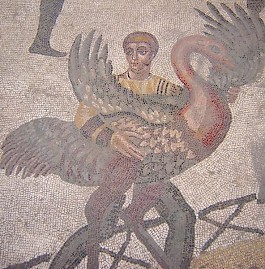
The new ruler of Italy and Sicily was the emperor Justinian, who initiated a conscious policy of re-hellenization that was continued by his successors. With administrative and ecclesiastical measures, the Byzantine emperors tried to create cultural and religious unity in their territories. They spent lots of money in Sicilian towns like Syracuse and Catania, which became important centers of the Byzantine civilization. Inscriptions from this age show the Greek language again; perhaps it was reintroduced as a new language on a Latin island, or perhaps a still extant language was revitalized. In any case, the Greek language and culture were reborn. When the Muslims approached the gates of Constantinople, the residence was even transferred (although briefly) to Syracuse - which shows that the emperors condidered Sicily sufficiently Greek.
In the mid-seventh century, when the Muslims had conquered northern Africa, Sicily was again threatened by raiders. The cities along the coast changed into fortresses, and the population moved to the interior. The Arabs invaded Sicily in 827. The Byzantine authorities were divided, and Palermo was taken in 831, Messina in 843, Syracuse in 878, and Taormina in 902. This marked the end of "classical" Sicily, and the beginning of a new age in which the island was a zone of cultural contact - this time between Islam and Christianity.